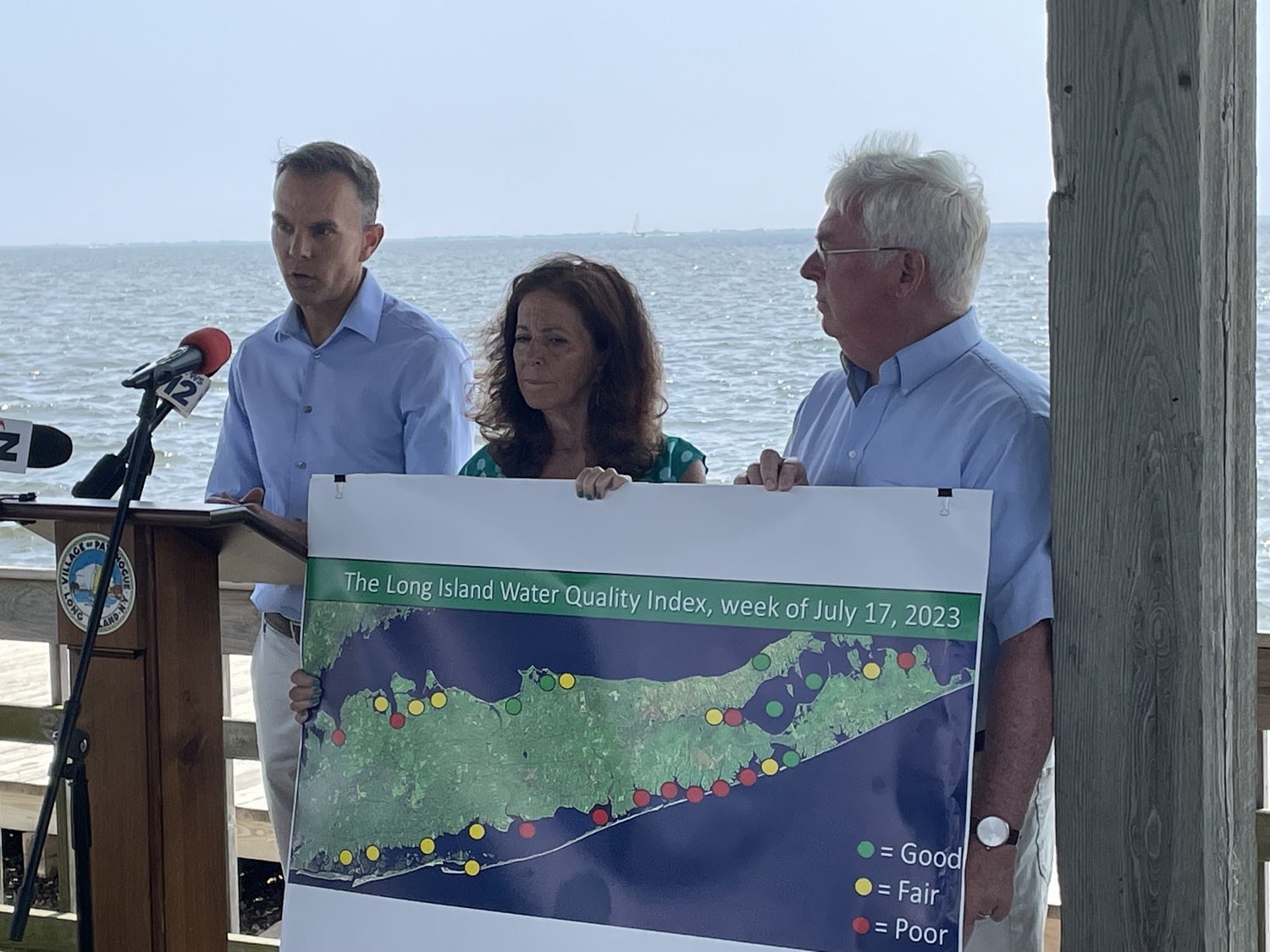
Water quality across the East End and much of Long Island cratered over the last two weeks as soaring temperatures and torrential downpours combined to spark algae blooms, bacterial loads and oxygen-starved waters in local bays.
The destructive algae blooms that have been dubbed the “rust tide,” for the color the blooms stain the water in long, tiger-like stripes, have exploded in Shinnecock Bay at densities that are deadly to any sea creatures unable to escape.
Fecal coliform bacteria levels have spiked in bays where groundwater laced with human waste feeds into bays.
Water in reaches of bays far from inlets and tidal flushing are a dingy brown or green, and are starved of oxygen.
Marine scientists from Stony Brook University closely monitor water quality at more than 30 sites across Long Island and reported this past week that only six sites met the criteria of “good” water quality, and only one, directly adjacent to Shinnecock Inlet, met state and federal water quality standards.
At locations from central Great South Bay to western Shinnecock Bay, and in the headwaters of Three Mile Harbor in East Hampton, the water failed all four of the main parameters used to measure water quality: algae densities, bacteria counts, water clarity and levels of dissolved oxygen.
“This month, as we hit these heat waves, water quality just fell through the floor,” said Dr. Christopher Gobler, who leads the Stony Brook researchers that monitor water quality across the region. “The bays went from a little cooler than average in early July, to almost peak temperatures in a matter of a week. And it’s not going to cool down anytime soon, from the look of things.”
Water temperatures in the Peconic have already topped the 80 degree mark — a temperature that is known to kill bay scallops and has been seen as one of the driving factors of massive die-offs the last four summers.
But the heat alone is not the fuel for the algae blooms that are expanding their destructive range daily.
“Those tropical deluges we got is what set it off,” Gobler said. “They love that. That’s the fuel on the fire. It pushes through the nutrients and ramps up the blooms.
“Last year, it was hot, but it was relatively dry, and the blooms were not as intense. But when you get those once-a-week deluges and the high temps, that’s when you see these counts really expand.”
Over the last decade, the East End, and much of the Northeast in general, has seen its normal rainfall pattern change significantly. Annual rainfall totals have remained about constant year over year, but the number of rainy days has dropped.
Rather than regularly spaced, moderately rainy days, the region tends to get most of its rain now in heavy or even extreme rain events that dump two or three inches or more in one short period, with long periods of dryness on either side. Nearly 5 inches of rain fell on the South Fork on July 16 — after a period of months with rainfall totals far below the historical average.
Those conditions, marine scientists have long warned, are the worst possible scenario for water quality. During dry periods, pollutants and nutrients from lawn fertilizers and pet waste build up on roads and lawns, and when a heavy rain comes, it flushes them into the bays in one giant dose. For the algae cells in the bay waters, that is like a can of spinach to Popeye.
The rust tide blooms, especially, respond to the influxes of nutrients following summer downpours. This week, scientists measured densities of the dinoflagellates that make up the blooms at 50,000 parts per milliliter. They had been barely 100 ppm just two weeks ago.
“If a wave of that hits a fish pen or aquaculture scallops, it can wipe them out overnight — I can speak to that from experience,” Gobler said of the dense rust tide blooms that have been seen in Moriches Bay, Shinnecock Bay and are expected to start spreading into the Peconic and Three Mile Harbor.
The scientists said that their water quality measurements show a clear pattern: locations in western Suffolk and Nassau County, where most homes are connected to sewer systems and waste water is treated by sewage treatment plants before being released back in to the environment, have markedly better water quality.
“As you hit that transition point between the sewered areas and the unsewered areas, the water quality drops from fair to poor,” Gobler said. “From central Great South Bay all the way to western Shinnecock, water quality is very poor — algae blooms, high fecal coliform bacteria, low water clarity and low dissolved oxygen.”
Stony Brook scientists were the first to definitively tie the rise of harmful angle blooms, or HABs, since the 1980s to influxes of human waste into groundwater tables that eventually flow into bays and ponds across eastern Suffolk. Obsolete and aging waste systems beneath homes built in the 1950s, 1960s and 1970s leach waste directly into groundwater in many cases, and the county and five East End towns have begun a campaign to replace cesspools and early septic systems with newer technology that greatly reduces the amount of nitrogen released.
About the only good news that scientists could report about water quality conditions this week is that there are still no signs of a bloom of “brown tide” — as the infamous algae blooms that wiped out native bay scallop and clam populations in the 1980s and 1990s were known.
“The Shinnecock Bay Restoration Project is doing very well and the most recent clam set was the best we’ve had yet — it doubled again this year,” Gobler said of the Stony Brook-led effort to seed clams in Shinnecock Bay as a way of helping improve water quality by increasing the densities of algae-consuming shellfish. “That, and there is still no brown tide. That is the only happy news.”